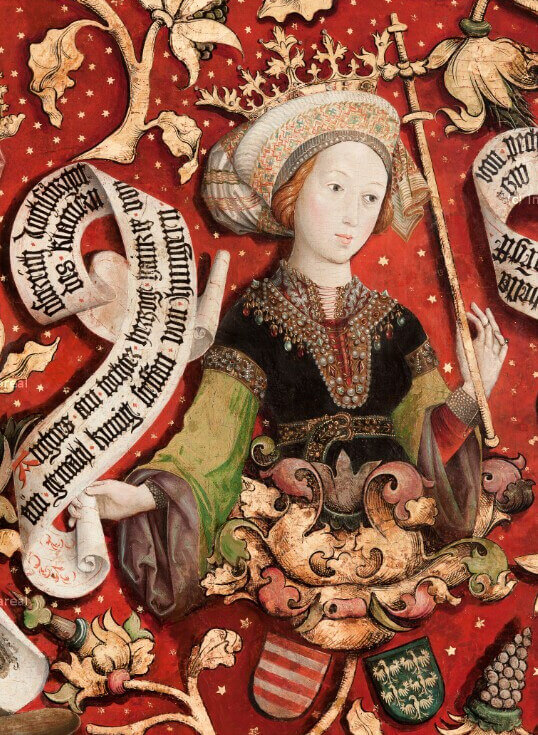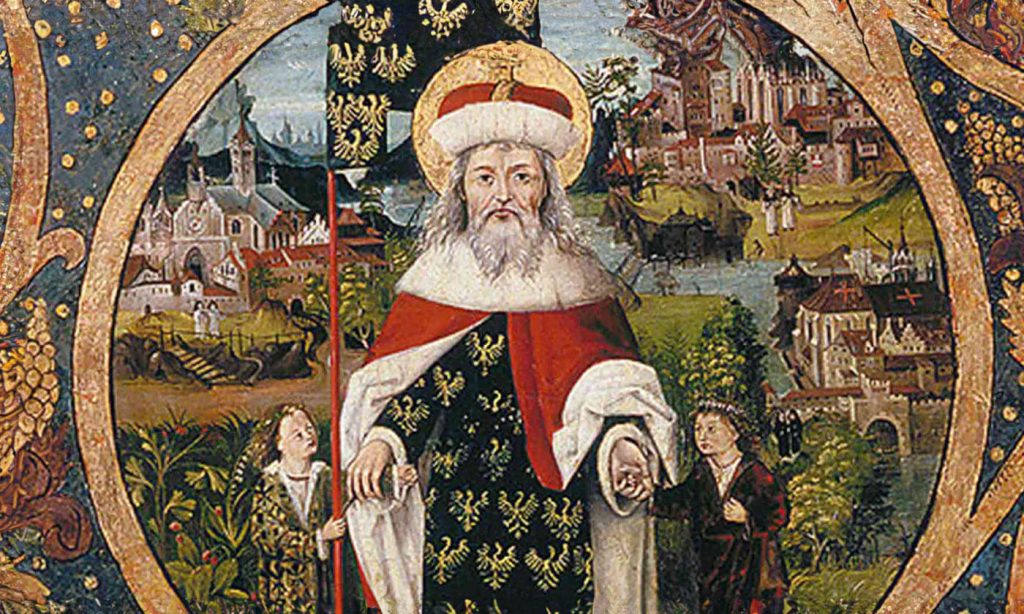Saint Leopold III was the Margrave of Austria from 1095 until his death in 1136. He was a member of the House of Babenberg. His first wife died in 1105 and his second wife was Agnes of Germany, the widowed daughter of Henry IV, (Holy Roman Emperor) with whom he had 17 children. He founded several monasteries in his lifetime, including the Klosterneuburg, Heiligenkreuz, Kleinmariazell and Seitenstetten monasteries. Saint Leopold III was canonized by Pope Innocence VIII in 1485. He is the patron saint of Austria, Lower Austria, Upper Austria and Vienna and his feast date is November 15.
The mystery of Saint Leopold’s successor
There was always speculation in historical documents regarding the reason why Saint Leopold III’s eldest son, Adalbert, was ignored in the line of succession in favor of another son, Leopold IV. Long-term historical discussions speculated that Adalbert was not Agnes’ son, but instead, he was Leopold’s son from his first marriage or an earlier unknown relationship. In 2013, scientists used DNA testing to try to solve this mystery.
Solving the mystery with genetic analyses
In an attempt to use DNA testing to investigate the relationship of Adlabert to his alleged parents, DNA samples were obtained from the skeletal remains of Saint Leopold III, his son, Adalbert and his second wife Agnes. Leopold III’s remains were buried in the middle tomb chamber in the monastery of Klosterneuburg, Lower Autria, which he founded in 1114. His son, Adalbert, was buried in the northern chamber, and his wife, Agnes, was buried in the southern chamber of the same monastery.
The sex-specific DNA test confirmed the gender of each skeleton – two males (Leopold and Adalbert) and one female (Agnes). Fifteen autosomal markers were then analyzed from each sample. This parentage analysis showed that Adalbert’s skeleton had one variant (or allele) in common with each parent at each marker tested – as expected for a parent-son relationship. The investigators then confirmed this parentage using both paternal (Y-DNA) and maternal (mitochondrial DNA) analyses.
Y-DNA is passed down from father to son along the direct paternal lineage. The results of the Y-DNA STR marker test showed that Adalbert’s Y-DNA STR marker profile was identical to Leopold III’s Y-DNA STR marker profile, indicating that they descended from the same paternal lineage, as would be expected for a true father and son pair.

Mitochondrial DNA (mtDNA) is passed down from mother to child along the direct maternal lineage. The results of the mtDNA analysis showed that Adalbert’s mtDNA profile was exactly the same as Agnes’ profile, except one minor length variation in the highly mutable C-rich region of the mtDNA. Disregarding the length variation seen in the C-rich region of the mtDNA, the haplotype obtained was a perfect match between Adlabert and Agnes and rare in the general population, suggesting that they descended from the same maternal lineage, as would be expected for a true mother and child pair.
Conclusions of the DNA study
The results of this DNA study confirmed that the remains taken from Adalbert’s gravesite belonged to a biological child of both Leopold III and Agnes. However, there are still some possible complications. In the middle of the 13th century, renovations took place in the monastery of Klosterneuburg and events had occurred with may have resulted in the mix up of the remains of Aldalbert and his younger brother Ernst (a known child of Leopold III and Agnes). DNA testing of the remains attributed to Ernst indicated that it belonged to an unrelated individual who was not the son of either Leopold III or Agnes. This leads to further speculation that the remains were accidentally swapped, and hence Adalbert was not a son of Leopold III or Agnes, and may have instead been an illegitimate son of Leopold III’s first wife. This scenario may explain why Adalbert (the eldest son) was ignored in the line of succession in favor of a younger son Leopold IV. Alternatively, the remains attributed to Ernst may instead belong to an unknown individual.
However, barring the possibility that the remains in the graves are not the correct individuals, the results of the autosomal parentage test, paternal ancestry test and maternal ancestry test all strongly support the hypothesis that Adalbert is truly the biological son of both Leopold III and Agnes. And maybe we will never known the true reason why he was not his father’s successor.

DNA Database Comparisons
The DNA tests conducted in this study have defined the Y-DNA STR paternal line profile of the paternal lineage of Leopold III and it has also defined the mtDNA maternal line profile of Agnes of Germany. Of particular interest is the maternal lineage of Agnes of Germany, as this lineage includes many notable historical figures, including:
– Bertha of Savoy
– Adelaide of Susa
– Henry V, Holy Roman Emperor
– Conrad II of Italy
– Frederick II Duke of Swabia
– Conrad III of Germany
If you have taken the mtDNA HVR1 and HVR2 (Advanced Maternal Ancestry) test, you can compare your DNA against members of this notable family to see if you may have descended from the same maternal lineage as Agnes of Germany. If you have taken the Y-DNA STR marker (Paternal Ancestry) test you can determine if you have descended from the same paternal lineage as Saint Leopold III.
DNA Ancestry Project Features
Ancestry Test
Mitochondrial DNA sequencing
Y-DNA STR fragment analysis
Autosomal STR fragment analysis
Advanced ethnic origins report
Recent ancestry analysis
Ancient ancestry analysis
DNA Ancestry Projects
Relationship match
Relationship confirmation









